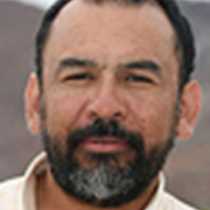Boca de la Soledad & Magdalena Island
Gray clouds and moderate winds were the frames for our whale watching activities this morning at Boca de la Soledad, or "Mouth of Solitude", in the northernmost entrance to Magdalena Bay. We boarded our Zodiac boats with our local permit holders and spent the whole day searching for the fantastic gray whales. Very soon several cow and calf pairs were observed as we got close to the Boca. Small and large blows were seen first followed by backs of different gray intensities and patterns. There were calves of light or dark gray skin, and cows with heavy ochre-colored barnacles and whale “lice” on their heads and sides. Various pairs or even trios of single males and females were also observed in their hurried mating race, as derived by their patterns of behavior. Today some babies were very active. They are growing fast and most of all might be between two and three weeks old. The cows (usually very protective when the calves are newborn or a few days old) allowed them to separate several yards and, to our delight, let them come very close to our Zodiacs. We continued this dynamic interaction throughout the morning and the sunny and warm afternoon.
The whales were just part of the whole natural performance. Hundreds of birds of different species were present in the water, flying or perched on the sand bars and shores. We were especially amazed by the number of cormorants and magnificent frigatebirds on the mangrove branches. To finish the afternoon, a couple of coyotes unveiled themselves on the muddy flats, in their eternal search for food in the complex environment of Magdalena Bay.
Gray clouds and moderate winds were the frames for our whale watching activities this morning at Boca de la Soledad, or "Mouth of Solitude", in the northernmost entrance to Magdalena Bay. We boarded our Zodiac boats with our local permit holders and spent the whole day searching for the fantastic gray whales. Very soon several cow and calf pairs were observed as we got close to the Boca. Small and large blows were seen first followed by backs of different gray intensities and patterns. There were calves of light or dark gray skin, and cows with heavy ochre-colored barnacles and whale “lice” on their heads and sides. Various pairs or even trios of single males and females were also observed in their hurried mating race, as derived by their patterns of behavior. Today some babies were very active. They are growing fast and most of all might be between two and three weeks old. The cows (usually very protective when the calves are newborn or a few days old) allowed them to separate several yards and, to our delight, let them come very close to our Zodiacs. We continued this dynamic interaction throughout the morning and the sunny and warm afternoon.
The whales were just part of the whole natural performance. Hundreds of birds of different species were present in the water, flying or perched on the sand bars and shores. We were especially amazed by the number of cormorants and magnificent frigatebirds on the mangrove branches. To finish the afternoon, a couple of coyotes unveiled themselves on the muddy flats, in their eternal search for food in the complex environment of Magdalena Bay.




